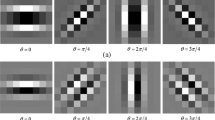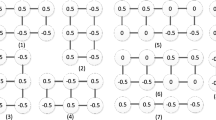Abstract
To improve the detection accuracy for adaptive JPEG steganography which constrains embedding changes to image texture regions difficult to model, a new steganalysis feature based on the Shannon entropy of 2-dimensional (2D) Gabor wavelets is proposed. For the proposed feature extraction method, the 2D Gabor wavelets which have certain optimal joint localization properties in spatial domain and in the spatial frequency are employed to capture the image texture characteristics, and then the Shannon entropy values of image filtering coefficients are used as steganalysis feature. First, the decompressed JPEG image is filtered by 2D Gabor wavelets with different scale and orientation parameters. Second, the entropy features are extracted from all the filtered images and then they are merged according to symmetry. Last, the ensemble classifier trained by entropy features is used as the final steganalyzer. The experimental results show that the proposed feature can achieve a competitive performance by comparing with the state-of-the-art steganalysis features for the latest adaptive JPEG steganography algorithms.
Access this chapter
Tax calculation will be finalised at checkout
Purchases are for personal use only
Similar content being viewed by others
Notes
- 1.
BossBase-1.01[EB/OL]. http://exile.felk.cvut.cz/boss/BOSSFinal/.2013.
References
Fridrich, J.: Steganography in Digital Media: Principles, Algorithms, and Applications. Cambridge University Press, Cambridge (2009)
Shannon, C.E.: A mathematical theory of communication. Bell Syst. Tech. J. 27(3), 379–423 (1948)
Filler, T., Fridrich, J: Design of adaptive steganographic schemes for digital images. In: Proceedings of SPIE, Electronic Imaging, Security and Forensics of Multimedia XIII, vol. 7880, pp. OF 1–14. SPIE (2011)
Wang, C., Ni, J.Q: An efficient JPEG steganographic scheme based on the block–entropy of DCT coefficients. In: Proceedings of IEEE ICASSP, pp. 1785–1788 (2012)
Guo, L.J., Ni, J.Q., Shi, Y.Q: An efficient JPEG steganographic scheme using uniform embedding. In: Proceedings of 4th IEEE International Workshop on Information Forensics and Security, pp. 169–174 (2012)
Holub, V., Fridrich, J: Digital image steganography using universal distortion. In: Proceedings of 1st ACM Information Hiding and Multimedia Security Workshop, pp. 59–68. ACM (2013)
Fridrich, J., Goljan, M., Soukal, D.: Wet paper codes with improved embedding efficiency. IEEE Trans. Inf. Forensics Secur. 1(1), 102–110 (2006)
Filler, T., Judas, J., Fridrich, J.: Minimizing additive distortion in steganography using syndrome-trellis codes. IEEE Trans. Inf. Forensics Secur. 6(1), 920–935 (2011)
Pevný, T., Fridrich, J: Merging markov and DCT features for multi-class JPEG steganalysis. In: Proceedings SPIE, Electronic Imaging, Security, Steganography, and Watermarking of Multimedia Contents IX, vol. 65053, pp. 1–14 (2007)
Chen, C., Shi, Y.Q.: JPEG image steganalysis utilizing both intrablock and interblock correlations. In: Proceedings of IEEE International Symposium on Circuits and Systems, pp. 3029–3032 (2008)
Kodovský, J., Fridrich, J., Holub, V.: On dangers of overtraining steganography to incomplete cover model. In: Proceedings of the 13th ACM Multimedia & Security Workshop, pp. 69–76. ACM (2011)
Song, X.F., Liu, F.L., Luo, X.Y., et al.: Steganalysis of perturbed quantization steganography based on the enhanced histogram features. Multimedia Tools Appl. 74(24), 11045–11071 (2015)
Kodovský, J., Fridrich, J: Steganalysis of JPEG images using rich models. In: Proceedings of SPIE, Electronic Imaging, Media Watermarking, Security, and Forensics of Multimedia XIV, vol. 8303, pp. 0A 1–13. SPIE (2012)
Holub, V., Fridrich, J.: Random projections of residuals for digital image steganalysis. IEEE Trans. Inf. Forensics Secur. 8(12), 1996–2006 (2013)
Holub, V., Fridrich, J.: Low complexity features for JPEG steganalysis using undecimated DCT. IEEE Trans. Inf. Forensics Secur. 10(2), 219–228 (2015)
Holub, V., Fridrich, J.: Phase-aware projection model for steganalysis of JPEG images. In: Proceedings of SPIE, Electronic Imaging, Media Watermarking, Security, and Forensics of Multimedia XIV, vol. 9409, pp. 94090T–94090T-11 (2015)
Kodovský, J., Fridrich, J., Holub, V.: Ensemble classifiers for steganalysis of digital media. IEEE Trans. Inf. Forensics Secur. 7(2), 432–444 (2012)
Daugman, J.G.: Uncertainty relation for resolution in space, spatial frequency, and orientation optimized by two-dimensional visual cortical filters. J. Opt. Soc. Am. A: 2(7), 1160–1169 (1985)
Pharwaha, A.P.S., Singh, B.: Shannon and non-Shannon measures of entropy for statistical texture feature extraction in digitized mammograms. In: Proceedings of the World Congress on Engineering and Computer Science, vol. 2, pp. 20–22 (2009)
Filler, T., Fridrich, J.: Gibbs construction in steganography. IEEE Trans. Inf. Forensics Secur. 5(4), 705–720 (2010)
Denemark, T., Sedighi, V., Holub, V., et al.: Selection-channel-aware rich model for steganalysis of digital images. In: Proceedings of IEEE International Workshop on Information Forensics and Security, pp. 1–5 (2014)
Grigorescu, S.E., Petkov, N., Kruizinga, P.: Comparison of texture features based on Gabor filters. IEEE Trans. Image Process. 11(10), 1160–1167 (2012)
Acknowledgments
This work was supported by the National Natural Science Foundation of China (No. 61272489, 61379151 and 61302159) and the Natural Science Basic Research Plan in Shaanxi Province of China (No. 2014JM2-6103).
Author information
Authors and Affiliations
Corresponding author
Editor information
Editors and Affiliations
Rights and permissions
Copyright information
© 2016 Springer International Publishing AG
About this paper
Cite this paper
Song, X., Li, Z., Chen, L., Liu, J. (2016). Entropy Feature Based on 2D Gabor Wavelets for JPEG Steganalysis. In: Wang, G., Ray, I., Alcaraz Calero, J., Thampi, S. (eds) Security, Privacy and Anonymity in Computation, Communication and Storage. SpaCCS 2016. Lecture Notes in Computer Science(), vol 10067. Springer, Cham. https://doi.org/10.1007/978-3-319-49145-5_7
Download citation
DOI: https://doi.org/10.1007/978-3-319-49145-5_7
Published:
Publisher Name: Springer, Cham
Print ISBN: 978-3-319-49144-8
Online ISBN: 978-3-319-49145-5
eBook Packages: Computer ScienceComputer Science (R0)




